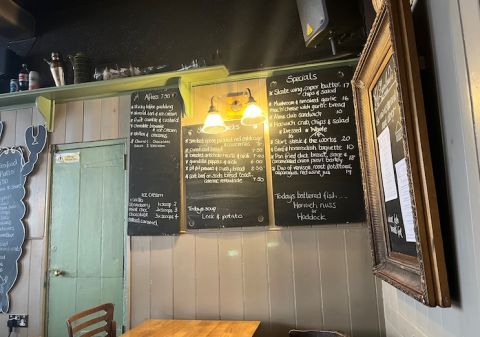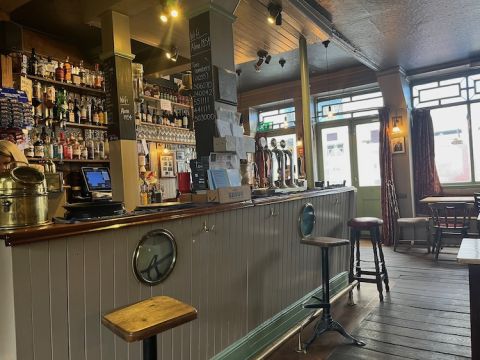The links between the Mayflower, the ship that transported several English families to what was to become the USA; the Kindertransport movement that brought 10,000 predominantly Jewish children to safety in the UK in 1939 (including two sisters who spent five years with my grandparents); and the first of my highlighted menus this week may not be immediately obvious. But please bear with me.
The principal connection is Harwich, a town on the Essex coast that was once a famous port but recently has lost considerable business to its neighbour Felixstowe. There still stands by its seafront a statue to the disembarking Kindertransport children. No more than 250 yards away is King’s Head Street and the home of Christopher Jones, who was the master of the Mayflower on that epic voyage.
The Alma Inn and Dining Rooms
Next door is the Alma Inn, part of the growing empire of chef Nick May, who once cooked in London but moved to Harwich when he saw how much space he could afford here by selling his London flat. When I saw him, he was wearing shorts and a T-shirt (it was absolutely freezing outside) as he was working on finishing the terrace of his new restaurant, Lambard’s Salt House, which is next to the Alma Inn.
The Alma’s interior makes for a welcoming sight. Lots of dark wood everywhere is coloured by the veneer of time. The bar houses stacks of bottles and numerous beer pumps offering mainly a host of Adnams’ beers while opposite is an open fire, continually fed with logs. In the far corner hang the collection of blackboard menus that supplement the printed one.
It took me some time to take in all the contents of these menus. The soup of the day was leek and potato, which I needed rather like a blood transfusion. It arrived hot and peppery with good bread and butter. After that I ordered a skate wing with capers and black butter. Time prevented me from enjoying a pudding, although I did have time to take a copy of the menu with me as usual, and to meet May.
I joined him at the bar and he explained that Lambard’s next door was unfortunately not open that day – he was waiting for a couple of chefs to return from their winter stint cooking in a ski resort before he would open during weekdays. He showed me the menu for the month of May, which opened with local asparagus three ways, went on to Harwich crab bisque, esqueixada (a Catalan dish of salt cod, tomato and onion), and a main course of grilled lamb chops (fire is an integral part of the Alba cooking repertoire). May sang the praises of his new home and extolled the efforts of the local tourist authority, in particular the fact that they have instituted the annual International Shanty Festival (the singing of sea shanties is a particularly popular pastime in this town) in October, thereby extending the summer season.
I paid my bill of £25 and set off for Harwich and Dovercourt High School, where I gave a talk to a room full of 13- to 16-year-olds as part of the valuable Speakers for Schools initiative. I began with my own early life before moving on to the pleasures of working in the hospitality industry, either as part of the front-of-house team or in the kitchen. This part fell on expectant ears as several of the older children already work in various restaurant kitchens, apparently, to earn extra money.
I was in luck. When I asked for any questions, one hand shot up, ‘What do you look for first, sir, when you walk into a restaurant?’ a bright boy asked. My answer was this: ‘Something, or some gesture, that will bring a smile to my face, something that will break the ice that can often exist when two strangers – that is me and the waiter – meet.’ And then I remembered that I took the menu from the Alma. I found it in my backpack and showed it around the room. This, particularly the pudding jokes, brought a smile to the faces of everyone in the room.
I would happily return to Harwich for a weekend when it is not so cold. Not so much for the sea shanties but for its history, its fish and shellfish, and for the warmth with which I was received.
A Wong
My second menu of the week comes from Andrew Wong’s A Wong restaurant in Victoria and could not be more different. While the Alma menu is far-reaching, containing dishes that May hopes will attract and excite customers of different dispositions and spending power, this second menu is far more direct.
Wong’s market is the highly interested visitor to London, somebody who is prepared to learn and to be intrigued by all the preparation Wong and his chefs (14 in the morning, 12 in the evening) put in and by all the ingredients he and his suppliers can find from China. It is a far more intellectual approach – one in which the customer learns while the chefs get obvious pleasure from watching their finished dishes leave the open kitchen. Watching this kitchen from my seat I was reminded of the Troisgros kitchen in Ouches, France, although this one was far more crowded. Both operate in near total silence.
As in every top restaurant around the world, the experience is expensive. It is £200 per person for the Taste of China menu at dinner, service not included. The experience is long, just short of three and a half hours, and it is not one that I would repeat more than once a year. But the cooking is exceptional. All the dishes are exquisite and extremely well thought out. Our waiter Roger explained every dish with painstaking detail. Below are the scalded oysters with ‘fish fragrant’ aubergine sauce, an extraordinary array of crisp ‘sandwiches’ and honey-glazed Ibérico pork char siu nudging into the top right-hand corner.
There were highlights in each course. The bowl of chilled ‘smacked’ cucumber with trout roe certainly got my appetite going; the Shanghai steamed dumplings showed just how good this somewhat traduced dish can be; the garlic-steamed prawns and the soy chicken with ginger as well as dried shrimp-and-coriander cheung fun were excellent – as were the fruits at the end of the meal, a finale that Wong has always emphasised as an essential element in Chinese cuisine. But most memorable of all was the thin slice of Nashi pear that had been coated with just the right amount of Sichuan pepper to provide the heat to almost counterbalance the sweetness of the fruit. With this we drank a delicious bottle of Grosset 2022 Polish Hill Riesling (£130) and a stunning Rousseau, Clos de la Roche 2009 brought by one of our fellow diners.
For Wong this menu represents another stage, not just in his personal development as a chef and as an inquisitive traveller around China, but also a further development in a location that has been his second home since 1985. Then it was parents’ restaurant, Kym’s, where, in what used to be an office but today is the pastry section, he and his sister used to get up to mischief. Today, as he and his wife renovate what used to be his parents’ home nearby, his two children should have somewhere slightly more spacious in which to do their homework.
The Alma Inn and Dining Rooms 25 King's Head Street, Harwich, Essex C012 3EE; tel: +44 (0)125 531 8681
A Wong 70 Wilton Road, London SW1V 1DE; tel: +44 (0)207 828 8931 (NB the lunchtime dim sum à la carte is much less expensive than the dinner menu)
Every Saturday, Nick writes about restaurants. To stay abreast of his reviews, sign up for our weekly newsletter.


















